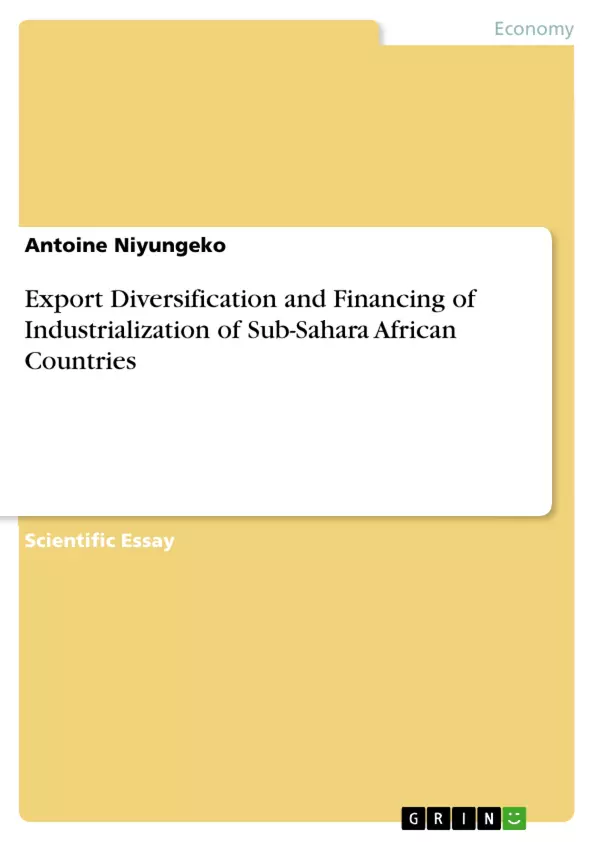This paper aims to examine the direct and indirect effects of foreign direct investment (FDI), development assistance (DA), and International Monetary Fund credit (IMFC) on the increase of exports (EXP) in Sub-Saharan African (SSA) countries. The study focuses on identifying the most influential factor in driving EXP, with a particular emphasis on sustainable financing strategies for export diversification and industrialization in SSA.
Traditionally, SSA has relied on FDI, development assistance (DA), remittances, and international credit for financial support. However, these sources of funding are expected to decrease due to the pandemic's economic impacts. The United Nations Conference on Trade and Development forecasts a significant decline in global FDI flows, with SSA facing a 25% to 40% reduction in investment flows for 2020. This underscores the urgency for SSA nations to explore sustainable financing methods for the necessary investments to boost exports.
Historically, SSA countries have utilized foreign direct investment (FDI) to fund economic development, but the outcomes have often fallen short, leaving many nations in poverty. Despite SSA's wealth of natural resources, efficient resource utilization remains a challenge, and potential advantages have not translated into inclusive growth.
The region also grapples with infrastructure gaps, poor investment climates, and weak governance and institutional capacities. In this context, it is imperative to consider alternative ways to finance economic growth, particularly export diversification and industrialization.
Research shows that export diversification and industrialization can significantly drive economic growth, but the question of how to finance these processes effectively remains largely unexplored. In the face of declining FDI and limitations within SSA's banking system, this study investigates the direct and indirect effects of FDI, DA, and IMFC on export expansion (EXP) and, subsequently, on gross domestic product (GDP).
The study delves into the mediating role of exports in various factors' impact on GDP, with the objective of identifying the most influential factor in driving export growth. Ultimately, this study aims to provide SSA leaders and policymakers with insights into innovative and sustainable financing approaches to promote export diversification and industrialization in the region.
Inhaltsverzeichnis (Table of Contents)
- Abstract
- Introduction
- Literature Review
- Methodology
- Research Results
- Result discussion and conclusion
- References
Zielsetzung und Themenschwerpunkte (Objectives and Key Themes)
This study explores the financing strategies for export diversification and industrialization in Sub-Saharan African (SSA) countries, particularly in the context of shrinking foreign direct investment (FDI). The research examines the impact of development assistance (DA), International Monetary Fund credit (IMFC), and FDI on exports (EXP), which in turn influence the gross domestic product (GDP). The study aims to identify the most impactful financing source for increasing exports and promoting inclusive economic development in SSA.
- Financing exports diversification and industrialization in SSA
- The role of FDI, DA, and IMFC in promoting exports
- The impact of exports on economic growth in SSA
- The challenges and opportunities for sustainable development in SSA
- The potential for utilizing IMF credit to support exports diversification and industrialization
Zusammenfassung der Kapitel (Chapter Summaries)
- Introduction: This chapter introduces the study's focus on financing export diversification and industrialization in SSA, highlighting the need for alternative financing strategies due to declining FDI and the impact of COVID-19. It discusses the economic challenges facing SSA and its potential for growth, emphasizing the importance of exports in promoting development.
- Literature Review: This chapter provides a comprehensive overview of existing research on export diversification, industrialization, and financing strategies in SSA. It explores the impact of FDI, DA, and IMFC on economic growth and highlights the need for a more integrated approach to development finance.
- Methodology: This chapter outlines the research design, including the variables used, data sources, and statistical methods employed. It describes the framework used to analyze the direct and indirect effects of FDI, DA, and IMFC on exports and economic growth.
- Research Results: This chapter presents the findings of the study, focusing on the relationship between FDI, DA, IMFC, exports, and economic growth in SSA. It analyzes the mediating role of exports in the relationship between financing sources and economic growth, identifying the most influential factors.
Schlüsselwörter (Keywords)
The key terms and concepts explored in this research include: foreign direct investment, development assistance, International Monetary Fund credit, exports, diversification, industrialization, Sub-Saharan Africa, economic growth, inclusive development, mediating role, and sustainable financing strategies. The study's findings and recommendations provide valuable insights for policymakers and development practitioners seeking to promote economic growth and inclusive development in SSA.
- Quote paper
- Antoine Niyungeko (Author), 2020, Export Diversification and Financing of Industrialization of Sub-Sahara African Countries, Munich, GRIN Verlag, https://www.grin.com/document/903756



